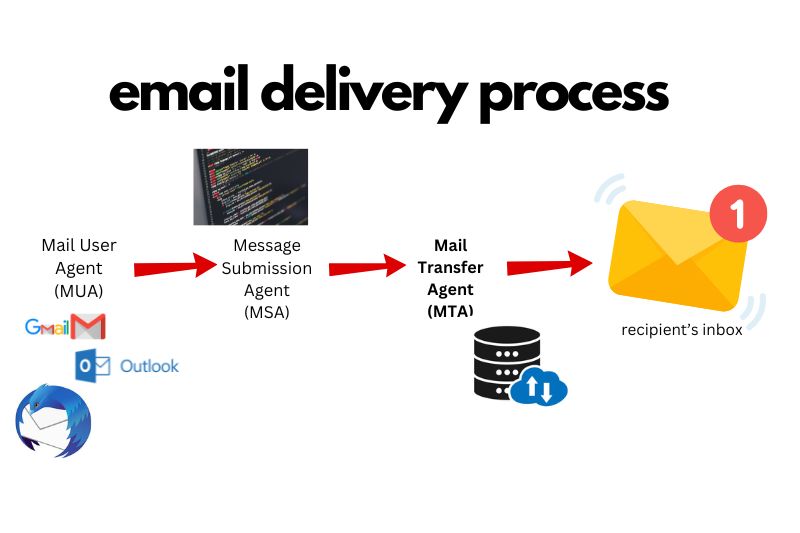Sending an email is like a relay race.
Your email is the baton, while the SMTP servers are the runners because their roles involve passing the baton from one to another until they reach the finish line.
The Mail Transfer Agent (MTA) is one of the runners. To be more specific, it’s the third runner in the relay race.
Curious to learn more about the role of MTA in your email marketing campaign and how correctly configuring it will significantly improve the performance and delivery of your campaigns? If yes, then you’re on the right track.
In this guide, you’ll learn what an MTA is, its role in email marketing, and many more. Keep reading until the end for tips on choosing the right MTA solution for your campaign.
What Is a Mail Transfer Agent (MTA)?
Mail Transfer Agent (MTA), also called the mail server, mail transport agent, mail router, or mail relay, is software that gets emails from the sender to the recipient.
The email delivery process is that the Mail User Agent (MUA or email client, for example, Microsoft Outlook, Apple Mail, Gmail, etc.) sends an email to the Message Submission Agent (also software). Then, the MSA sends the message to the MTA.
Here’s how the process looks:
Relaying comes into play the moment the MTA receives the email. This is why MTAs are often referred to as mail relays. The MTA maintains a queue of emails to schedule repeat delivery if the receiver is unavailable.
Some examples of MTAs are Postfix, Sendmail, PowerMTA, KumoMTA, Momentum, and Halon.
The MTA, MUA, and MSA are all components of the Simple Mail Transfer Protocol (SMTP).
There’s another component besides those three: the Mail Delivery Agent (MDA). If it’s likened to a relay race, the MDA is the fourth runner. Its role is to deliver mail to the local system.
MTAs often use a store-and-forward mail handling model. In such a setup, outgoing mail is put in a queue, waiting for a response from the recipient’s server. It will try to send emails, but these emails can be returned to the mail client if they fail to get delivered in a certain period.
Related: SMTP Server – All You Need to Know

Is It The Same as the Simple Mail Transfer Protocol?
No, an MTA is not the same as the SMTP. However, it is a component of SMTP.
The Simple Mail Transfer Protocol is an application-layer protocol or communication protocol used by mail servers to send, receive, and relay emails between senders and receivers.
The Role of MTAs in Email Marketing
MTAs handle everything from sending to delivering emails to the recipient’s inbox. This includes some operations:
- Queueing: It stores emails in a queue until they are delivered to the recipient’s server.
- Accepting: It accepts emails from the mail users’ agents.
- Querying: It queries the MX records and chooses the mail server to transfer emails.
- Scheduling: It determines the optimal time to send emails based on different factors, such as the recipient’s time zone.
- Rate Limiting: It regulates the pace at which emails are sent to avoid triggering spam markers and overwhelming the receiving server.
- Sending: It sends auto-respond messages whenever an email fails to reach its destination. It also handles temporary email delivery failures, like when the server is down or busy.
- Transferring Data: It moves email data (attachments, content, etc.) from one point to another through the network.
- Connection Administration: It supervises the upkeep, initiation, and termination of network connections used in email exchange.
- Addressing Delivery Delays: This addresses temporary obstacles in mail delivery, like temporarily inactive or busy recipients’ servers.
- Tracking Delivery: It monitors and records the status of emails, whether they’re in the queue, it’s delivered, or bounced.
Related: Mastering SPF Syntax: A Step-by-Step Guide
How the MTA Works and How It Affects Your Email Deliverability
First, it initiates the email journey by creating a message and sending it to the MSA. The MSA will then format the content and pass it on to the MTA.
Second, it improves your sender’s reputation.
Your sending reputation (like a credit history of how your domain has performed over time) is one factor that affects your email deliverability, and the MTA impacts it.

Okay, here are some of the reasons why.
An MTA can drop campaigns that negatively impact your reputation. It can also optimally use its features. In addition, it can help warm up your IP addresses so that they can be used to send emails effectively.
An MTA can likewise limit your sending according to the patterns you have set. In the same way, it can help you back off the moment you reach a percentage of failures in delivery attempts.
If you have a poor sending reputation that results in low deliverability, you may want to consider an email deliverability tool like InboxAlly.
It not only repairs or increases deliverability on any domain, but it also allows users to select a preset engagement profile for reputation protection. Learn more about how it can supercharge your email marketing efforts.
Besides these effects, MTAs enable email marketers to do much more. They can help you break through the grey list. Email greylisting is a preventive measure used by email providers to stop spam attacks. If an email is greylisted, it has been temporarily blocked.
An MTA works by arranging queues and making multiple attempts to deliver emails until they are finally accepted.
Two Main Types of MTA Servers
The MTA servers come in two types: the On-premise MTA servers and the Cloud-based SMTP server.
On-Premise MTA Servers
These are mostly hosted by large companies or enterprises with an in-house email infrastructure that has both hardware and software components. Basically, all transferred emails are stored in an indexed database.
Cloud-Based SMTP Servers
These are cloud-based infrastructures necessary for email transfer. Examples of these servers are services like Mailgun and SendGrid.
Some business owners and email marketers prefer this type of MTA server because it is inexpensive. Still, it doesn’t allow full control over the delivery infrastructure and mail sending.

Tips in Choosing the Right MTA Solution For Your Campaign
When choosing the right MTA solution for your project, decide based on your resources and goals. These things should be in your focus:
Security
Choose an MTA solution that is secured to protect your and your clients’ information. It should at least include antimalware, spam filter, encryption, and data loss prevention features.
Compatibility and Flexibility
It’s better if the service or tool can sync with mobile and web-based applications, like contact applications, calendars, and email.
Consider whether it supports multiple platforms as well. This is more important if your business uses various email clients and operating systems. This flexibility feature warrants smooth communication in different environments.
Email Archiving and Storage
The MTA solution should offer sufficient storage for archiving. You may also choose one with a feature automatically archives old electronic mail messages.
Performance
This defines the latency, speed, and volume of emails sent. Dedicated MTAs typically allow full control over sending parameters and enable tracking performance and other metrics.
Configurability
Does the MTA solution give you access to specific configurations to improve its performance? For instance, does it allow real-time troubleshooting? Does it enable authentication or set up multiple mail queues?
Compliance with Standards
Choose an MTA that follows industry standards, such as POP, IMAP, and SMTP, to ensure it functions well with different email systems. It likewise lessens the risk of communication issues.
Budget
Cloud-based email services are inexpensive and require less maintenance. However, on-premises email servers are more secure and offer fine-grained control over systems.

Best Mail Transfer Agents
Let’s look at some of the popular mail transfer agents (open-source software):
- Microsoft Exchange Server is developed by Microsoft. This MTA has tools for managing public folders, shared mailboxes, and distribution groups.
- Postfix is a popular open-source MTA compatible with Sendmail. It supports TLC encryption, access control lists, and sender policies.
- Amazon SES is a cloud-based email-sending platform by Amazon Web Services. It offers a pay-as-you-go pricing model, allowing you to pay only for the features you use. One of its highlights is that it handles high volumes of transactional and marketing emails.
Conclusion
Here’s the bottom line: Mail Transfer Agents play an important role in email marketing.
They can optimize your campaigns by taking care of various tasks, such as queueing, accepting, querying, scheduling, sending, transferring data, and tracking the delivery.
If your business often uses email, such as email marketing or transactional emails, using a dedicated MTA to handle substantial volumes is beneficial. Doing so improves your ability to reach potential customers and will help you prevent email security issues.
Ensure your emails get delivered directly to your recipients’ inboxes without getting blocked or filtered.
Use InboxAlly, the ultimate deliverability tool, to give your email greater visibility and a higher chance of being read. Try it for free.
